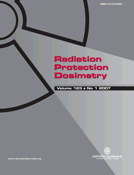-
Views
-
Cite
Cite
C. Papastefanou, Radiation dose from cigarette tobacco, Radiation Protection Dosimetry, Volume 123, Issue 1, January 2007, Pages 68–73, https://doi.org/10.1093/rpd/ncl033
Close - Share Icon Share
Abstract
The radioactivity in tobacco leaves collected from 15 different regions of Greece before cigarette production was studied in order to estimate the effective dose from cigarette tobacco due to the naturally occurring primordial radionuclides, such as 226Ra and 210Pb of the uranium series and 228Ra of the thorium series and or man-made radionuclides, such as 137Cs of Chernobyl origin. Gamma-ray spectrometry was applied using Ge planar and coaxial type detectors of high resolution and high efficiency. It was concluded that the annual effective dose due to inhalation for adults (smokers) for 226Ra varied from 42.5 to 178.6 μSv y−1 (average 79.7 μSv y−1), while for 228Ra from 19.3 to 116.0 μSv y−1 (average 67.1 μSv y−1) and for 210Pb from 47.0 to 134.9 μSv y−1 (average 104.7 μSv y−1), that is the same order of magnitude for each radionuclide. The sum of the effective doses of the three natural radionuclides varied from 151.9 to 401.3 μSv y−1 (average 251.5 μSv y−1). The annual effective dose from 137Cs of Chernobyl origin was three orders of magnitude lower as it varied from 70.4 to 410.4 nSv y−1 (average 199.3 nSv y−1).



